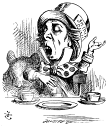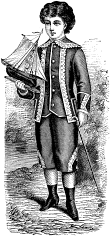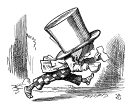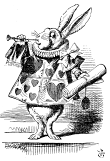Search us!
Search The Word Detective and our family of websites:
This is the easiest way to find a column on a particular word or phrase.
To search for a specific phrase, put it between quotation marks. (note: JavaScript must be turned on in your browser to view results.)
Ask a Question! Puzzled by Posh?
Confounded by Cattycorner?
Baffled by Balderdash?
Flummoxed by Flabbergast?
Perplexed by Pandemonium?
Nonplussed by... Nonplussed?
Annoyed by Alliteration?

Don't be shy!
Send in your question!
Columns from 1995 to 2006 are slowly being added to the above archives. For the moment, they can best be found by using the Search box at the top of this column.
 If you would like to be notified when each monthly update is posted here, sign up for our free email notification list.
If you would like to be notified when each monthly update is posted here, sign up for our free email notification list.
Trivia
All contents herein (except the illustrations, which are in the public domain) are Copyright © 1995-2020 Evan Morris & Kathy Wollard. Reproduction without written permission is prohibited, with the exception that teachers in public schools may duplicate and distribute the material here for classroom use.
Any typos found are yours to keep.
And remember, kids,
Semper Ubi Sub Ubi
|
Blame it on the bird.
Dear Word Detective: What is the origin of the term “pie-eyed”? Apparently the word “pie” is from the printing trade meaning “a muddle of words or letters.” Does the meaning lie there? — Wendy.
Not exactly. English has two kinds of “pie.” The older “pie,” first appearing in Old English, is the original name for the bird we now call a “magpie.” Just where the “mag” came from is uncertain, but it is probably short for “Margaret,” a custom of the day being adding personal names to those of animals (e.g., Tom Turkey, Jenny Wren, etc.). The root of “pie” in English is the Latin name for the magpie, “pica,” which is related to the Latin for woodpecker, “picus.”
 Magpies are known for three characteristics: their striking black and white plumage, their raucous calls, and their habit of collecting strange assortments of things in their nests (bits of string, shiny objects, etc.). The magpie’s feathers gave us the adjective “pied” in the 14th century, meaning “streaked or marked with black and white” (as in a “piebald” horse, the “bald” referring to the white patches). “Pied” was later extended to mean “multicolored,” as in the “Pied Piper” of the fable, who was dressed in clothes of many colors. Magpies are known for three characteristics: their striking black and white plumage, their raucous calls, and their habit of collecting strange assortments of things in their nests (bits of string, shiny objects, etc.). The magpie’s feathers gave us the adjective “pied” in the 14th century, meaning “streaked or marked with black and white” (as in a “piebald” horse, the “bald” referring to the white patches). “Pied” was later extended to mean “multicolored,” as in the “Pied Piper” of the fable, who was dressed in clothes of many colors.
The second sort of “pie” is the familiar dish, a pastry shell filled with an assortment of ingredients, usually including either meat or fruit. This “pie” appeared in English several hundred years after “pie” meaning “magpie,” and opinions vary as to the origin of this “pie.” But the first edible “pies” were a jumble of meat and vegetables, reminiscent of a magpie’s trove of odd objects, making it probable, in the view of many authorities, that the two “pies” are actually the same word. The bird’s quirky housekeeping, in short, gave us our modern “pie.” A similar linkage ties the name of the Scottish dish “haggis” (a meat and vegetable concoction) to “haggess,” a 16th century English name for the magpie.
The printers’ term “pie” for a jumble of letters so disordered as to resemble the makings of a pie is just one of the descendants of “pie” the food (and, in fact, printers adopted the Latin name of the magpie, “pica,” for a style of type). “Pie” has also been pressed into service as a metaphor for “the whole” of anything (“They want a bigger slice of the pie”), an index of simplicity (“easy as pie,” probably referring to the eating of pie, not the making), and even a sardonic comment on promises of happiness in the afterlife (“Pie in the sky,” coined by labor organizer and troubadour Joe Hill in 1911). “Pie-eyed,” usually meaning “extremely drunk” or “extremely tired,” dates to 1900 and comes from the fixed, wide-eyed stare of the afflicted, with eyes as wide and blank as the top of a pie (“They put him down at a Table and sat around him and inhaled the Scotch until they were all Pie-Eyed,” George Ade, 1904).
Why is Uncle Albert wearing that funny jacket?
Dear Word Detective: We are wondering if the word “idiot” had the same definition in 1700 as it does today. We are working on a family history. — Joan.
 Isn’t genealogy fun? You learn all sorts of interesting things about your ancestors. I read recently that genealogical websites are among the most popular on the internet. The quality of these sites varies greatly, of course, so it’s important to choose carefully. I am very skeptical, for instance, of the one that informed me that I’m actually descended from Eskimo pole-dancers and offered me an opportunity to meet some of my relatives (“They have a hundred words for hot!”). Isn’t genealogy fun? You learn all sorts of interesting things about your ancestors. I read recently that genealogical websites are among the most popular on the internet. The quality of these sites varies greatly, of course, so it’s important to choose carefully. I am very skeptical, for instance, of the one that informed me that I’m actually descended from Eskimo pole-dancers and offered me an opportunity to meet some of my relatives (“They have a hundred words for hot!”).
Although your question might be mistaken for the setup to a Rodney Dangerfield routine, it’s far from impossible that “idiot” might have meant something other than “stupid person” in 1700. Words frequently change their meanings over time, sometimes radically. An oft-cited example is the word “nice,” which today we use to mean “pleasant, agreeable, friendly.” But the root of “nice” is the Latin “nescius,” meaning literally “ignorant” (from “ne,” not, plus a form of the verb “scire,” meaning “to know,” also the root of our modern word “science”). When “nice” entered English in the 12th century from the Old French, it meant “ignorant” or “stupid,” and by the 14th century it was being used to mean “wanton” or “immoral.” But things started to look up for “nice” a century later, when it began to be used to mean first “shy,” then “refined” and “fastidious.” Eventually, in the 19th century, it took on the modern meaning of “pleasant.”
“Idiot” is another word that has changed its meaning over the centuries, although not as dramatically as “nice” once it was imported into English. The Greek “idiotes” meant simply “private individual” (from “idios,” meaning “personal”), as opposed to a “public man,” a politician or other well-known individual. (“Idios” also gave us “idiom,” one’s own way of speaking, and “idiosyncrasy,” one’s personal quirks and habits.)
By the time English imported “idiot” from French in the 13th century, however, “idiot” had already fallen on hard times, linguistically speaking. From “private individual,” it had evolved to mean “layman” or “uneducated common man,” and by the time it appeared in English “idiot” had come to primarily mean “ignorant person,” or, as the Oxford English Dictionary (OED) helpfully puts it, “a simple man; a clown.” Almost all usage of “idiot” in the subsequent centuries has reflected this general sense of “fool.”
There is, however, a bright spot in the history of “idiot” in the 17th century. In the mid-1600s, according to the OED, there was a spike in the use of “idiot” in the old sense of “layman, untrained amateur” (“Idiots admire in things the Beauty of their Materials, but Artists that of the Workmanship,” 1663), as well as the sense of “private person.” So there’s a possibility that anyone referred to as an “idiot” in that period was guilty of nothing more than not being an expert.
And the occasional turtle.
Dear Word Detective: My goodness! Your site is just as bad (or good) as a dictionary. I start out to look up one thing and get sidetracked with all the other interesting things I find. However, my question concerns the word “snip” (plural “snips”), as in the nursery rhyme, “Snips and snails and puppy dog tails, that’s what little boys are made of.” The word came up as my husband and I were discussing our grandson (who is the pride and joy of both his father and grandfather). Our discussion on possible sources ranged over a wide area, some rather improbable. Thanks for any help. — Betty.
 You just had to bring up that rhyme, didn’t you? That “snips and snails and puppy dog tails” thing has bothered me ever since I first heard it because it is so utterly unfair. Let’s see, girls are “sugar and spice and everything nice,” right? Doesn’t leave boys much to shoot for, does it? But even so, “snails”? As a small boy, snails gave me the wimwams. And since I was acquainted with the hygiene (or lack thereof) of our family dog, “puppy dog tails” wasn’t very appetizing either. As for “snips,” it sounded like the stuff left on the floor after a haircut. It doesn’t help that other versions of the poem (usually attributed to the 19th century British poet Robert Southey) substitute “slugs” or “snakes” for “snips,” or that some scholars think that the phrase was originally “snips of snails.” Oh goody, ragged bits of slimy snails and smelly dogs’ tails. No wonder I was lousy at baseball. You just had to bring up that rhyme, didn’t you? That “snips and snails and puppy dog tails” thing has bothered me ever since I first heard it because it is so utterly unfair. Let’s see, girls are “sugar and spice and everything nice,” right? Doesn’t leave boys much to shoot for, does it? But even so, “snails”? As a small boy, snails gave me the wimwams. And since I was acquainted with the hygiene (or lack thereof) of our family dog, “puppy dog tails” wasn’t very appetizing either. As for “snips,” it sounded like the stuff left on the floor after a haircut. It doesn’t help that other versions of the poem (usually attributed to the 19th century British poet Robert Southey) substitute “slugs” or “snakes” for “snips,” or that some scholars think that the phrase was originally “snips of snails.” Oh goody, ragged bits of slimy snails and smelly dogs’ tails. No wonder I was lousy at baseball.
Assuming the word in the nursery rhyme really is “snips” all by itself, it’s probably the least offensive item in that libelous inventory of boyhood. The verb “to snip” first appeared in English in the late 16th century, probably derived from the Low German word “snippen” (to snip or shred), with the meaning “to take something quickly; to snatch.” The origin of “snip” is apparently “echoic,” i.e., the sound of the word imitates a quick, sharp action.
Pretty quickly, however, “snip” took on its modern meaning of “to cut, as if with scissors,” with the sense that the cut is small and quick. In the 18th century, “snip” begat the adjective “snippy,” originally meaning “stingy” but today meaning “nasty” or “coldly critical” (“Well, you don’t have to get snippy,” Al Gore to George W. Bush, Nov. 7, 2000).
“Snip” as a noun appeared at about the same time as the verb, meaning “a small piece of something cut off, especially of cloth.” Various figurative uses of “snip” have evolved over the years, from “a young or small person” to slang uses meaning “a sure thing” and “a bargain.” The sense of “snip” in “snips and snails,” etc., is probably “small pieces of things,” perhaps odds and ends of the sort collected by small boys. Speaking as one who used to routinely carry rocks and bits of string in his pockets, that’s OK with me, but I still don’t like snails.
|
Makes a great gift! Click cover for more.  
400+ pages of science questions answered and explained for kids -- and adults!
FROM ALTOIDS TO ZIMA, by Evan Morris
 
|
 Magpies are known for three characteristics: their striking black and white plumage, their raucous calls, and their habit of collecting strange assortments of things in their nests (bits of string, shiny objects, etc.). The magpie’s feathers gave us the adjective “pied” in the 14th century, meaning “streaked or marked with black and white” (as in a “piebald” horse, the “bald” referring to the white patches). “Pied” was later extended to mean “multicolored,” as in the “Pied Piper” of the fable, who was dressed in clothes of many colors.
Magpies are known for three characteristics: their striking black and white plumage, their raucous calls, and their habit of collecting strange assortments of things in their nests (bits of string, shiny objects, etc.). The magpie’s feathers gave us the adjective “pied” in the 14th century, meaning “streaked or marked with black and white” (as in a “piebald” horse, the “bald” referring to the white patches). “Pied” was later extended to mean “multicolored,” as in the “Pied Piper” of the fable, who was dressed in clothes of many colors.

 can be found
can be found 
 Isn’t genealogy fun? You learn all sorts of interesting things about your ancestors. I read recently that genealogical websites are among the most popular on the internet. The quality of these sites varies greatly, of course, so it’s important to choose carefully. I am very skeptical, for instance, of the one that informed me that I’m actually descended from Eskimo pole-dancers and offered me an opportunity to meet some of my relatives (“They have a hundred words for hot!”).
Isn’t genealogy fun? You learn all sorts of interesting things about your ancestors. I read recently that genealogical websites are among the most popular on the internet. The quality of these sites varies greatly, of course, so it’s important to choose carefully. I am very skeptical, for instance, of the one that informed me that I’m actually descended from Eskimo pole-dancers and offered me an opportunity to meet some of my relatives (“They have a hundred words for hot!”). You just had to bring up that rhyme, didn’t you? That “snips and snails and puppy dog tails” thing has bothered me ever since I first heard it because it is so utterly unfair. Let’s see, girls are “sugar and spice and everything nice,” right? Doesn’t leave boys much to shoot for, does it? But even so, “snails”? As a small boy, snails gave me the wimwams. And since I was acquainted with the hygiene (or lack thereof) of our family dog, “puppy dog tails” wasn’t very appetizing either. As for “snips,” it sounded like the stuff left on the floor after a haircut. It doesn’t help that other versions of the poem (usually attributed to the 19th century British poet Robert Southey) substitute “slugs” or “snakes” for “snips,” or that some scholars think that the phrase was originally “snips of snails.” Oh goody, ragged bits of slimy snails and smelly dogs’ tails. No wonder I was lousy at baseball.
You just had to bring up that rhyme, didn’t you? That “snips and snails and puppy dog tails” thing has bothered me ever since I first heard it because it is so utterly unfair. Let’s see, girls are “sugar and spice and everything nice,” right? Doesn’t leave boys much to shoot for, does it? But even so, “snails”? As a small boy, snails gave me the wimwams. And since I was acquainted with the hygiene (or lack thereof) of our family dog, “puppy dog tails” wasn’t very appetizing either. As for “snips,” it sounded like the stuff left on the floor after a haircut. It doesn’t help that other versions of the poem (usually attributed to the 19th century British poet Robert Southey) substitute “slugs” or “snakes” for “snips,” or that some scholars think that the phrase was originally “snips of snails.” Oh goody, ragged bits of slimy snails and smelly dogs’ tails. No wonder I was lousy at baseball.



Recent Comments